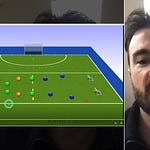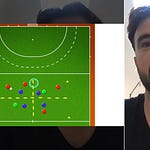In this workshop, we delve into the intricacies of practice session design, specifically focusing on how to translate game situations into effective training plans. Using the scenario of a red card during a match, we'll explore strategies for overcoming defensive blocks and optimizing team performance through well-structured practice sessions.
Introduction to the Workshop
The workshop focused on enhancing practice session design through real game situations. Today, we will explore a specific scenario: when an opponent receives a red card, leaving them with fewer players on the field. This situation can create unique challenges, particularly in overcoming a block defense. Our goal is to equip experienced coaches with effective strategies to adapt their training sessions accordingly.
Understanding Game Situations
Game situations are dynamic and can significantly influence how a match unfolds. Understanding these scenarios allows coaches to tailor their practice sessions to mimic real-game conditions. For instance, when an opponent is down to ten players, they often adopt a more defensive posture. Our focus will be on how to manipulate that defense effectively while maintaining possession and creating scoring opportunities.
Weekly Training Program Structure
A well-structured weekly training program is essential for consistent player growth. Each week should include a variety of sessions that build upon one another. Here’s a suggested structure:
Monday: Introduction meeting and warm-up, followed by skill development drills.
Tuesday: Tactical session focusing on game situations, including block defense strategies.
Wednesday: Conditioning and agility training.
Thursday: Scrimmage integrating skills learned during the week.
Friday: Review and feedback session, followed by a light practice.
Contextual Game Situation: GB vs. India
To illustrate the concepts we'll be discussing, let's analyze a specific game situation: the quarter-final match between Great Britain (GB) and India at the Olympic Games in Paris. During this match, India received a red card, resulting in them playing with one fewer player for a significant portion of the game. This scenario provides a rich context for understanding how to adjust our practice session design to effectively counteract a block defense.
Analyzing the Game Situation
In this match, GB faced the challenge of breaking through a well-organized Indian defense. With India playing with ten players, they focused on maintaining a strong block in the center of the field. GB had to find ways to penetrate this defense while ensuring they maintained control of the ball. Key questions to consider include:
How can GB exploit the numerical advantage?
What tactics can be employed to create space and scoring opportunities?
How does the positioning of players affect the ability to break through the defense?
Strategies to Manipulate Block Defense
To effectively manipulate a block defense, coaches should consider several strategies:
Create 2v1 Situations: By drawing defenders out of position, teams can create numerical advantages in key areas.
Use Width: Spreading the play can stretch the defense and open up gaps for attackers to exploit.
Increase Mobility: Encourage players to move dynamically to create passing lanes and opportunities for quick ball movement.
Technical Points for Training Focus
When designing training sessions, it is essential to focus on specific technical skills that will enhance player performance in game situations. Key areas to concentrate on include:
Listen to this episode with a 7-day free trial
Subscribe to The Hockey Site to listen to this post and get 7 days of free access to the full post archives.














